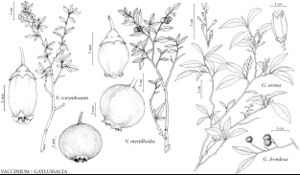Gaylussacia ursina
Mem. Amer. Acad. Arts, n. s. 3: 49. 1846,.
Plants 3–10 (–15) dm, forming small to extensive colonies; branches spreading; twigs of current season pale green to light-brown, sparsely hairy. Leaves: petiole 1–2 mm; blade greenish white abaxially, green to yellowish green or reddish green adaxially, ovate to oblong, 2.5–6 × 2.3–4 cm, membranous, base rounded to cuneate, margins entire, apex acute to acuminate, abaxial surface sessile-glandular, hairy along veins, adaxial surface glabrous. Inflorescences spreading or drooping, 4–6-flowered, bracteate, 0.7–2.5 cm, glabrous; bracts early-deciduous, leaflike, 1–2 mm, shorter than pedicels, glabrous, sessile-glandular. Pedicels 6–9 mm, sparsely hairy (hairs red), sessile-glandular; bracteoles 1–2, 1–1.5 mm. Flowers: sepals 5, 0.5 mm, glabrous, sparsely sessile-glandular; petals 4–5, corolla greenish white, urceolate, 4–5 mm, lobes ovate-deltate, ca. 1 mm; filaments 3–3.5 mm, glabrous; anthers included, 1 mm, thecae not divergent; ovary glabrous. Drupes juicy, sweet, glossy black, 7–10 mm diam., glabrous. Seeds 1 mm, smooth.
Phenology: Flowering late spring.
Habitat: Deciduous or open pine woods (often dominant in Table Mountain Pine-Pitch Pine Woodland), common in moister forests downslope, often associated with Rhododendron maximum
Elevation: 500-1500 m
Distribution

Ga., N.C., S.C., Tenn.
Discussion
Gaylussacia ursina is a southern Appalachian Mountains endemic that often forms large, clonal patches; it is abundant within much of its narrow range.
Selected References
None.
Lower Taxa
"entire" is not a number."dm" is not declared as a valid unit of measurement for this property.
